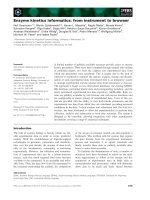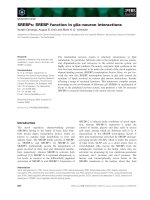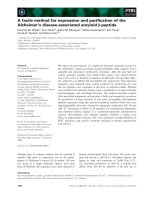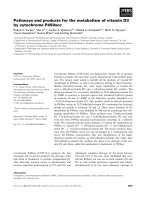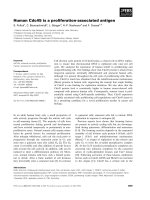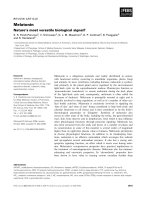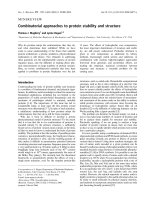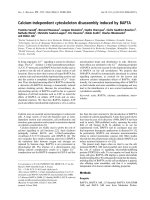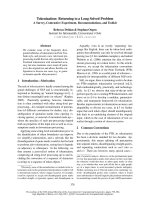Tài liệu Báo cáo khoa học: "Statistical phrase-based models for interactive computer-assisted translation" pdf
Bạn đang xem bản rút gọn của tài liệu. Xem và tải ngay bản đầy đủ của tài liệu tại đây (351.13 KB, 7 trang )
Proceedings of the COLING/ACL 2006 Main Conference Poster Sessions, pages 835–841,
Sydney, July 2006.
c
2006 Association for Computational Linguistics
Statistical phrase-based models for interactive computer-assisted
translation
Jes
´
us Tom
´
as and Francisco Casacuberta
Instituto Tecnol
´
ogico de Inform
´
atica
Universidad Polit
´
ecnica de Valencia
46071 Valencia, Spain
{jtomas,fcn}@upv.es
Abstract
Obtaining high-quality machine transla-
tions is still a long way off. A post-
editing phase is required to improve the
output of a machine translation system.
An alternative is the so called computer-
assisted translation. In this framework, a
human translator interacts with the sys-
tem in order to obtain high-quality trans-
lations. A statistical phrase-based ap-
proach to computer-assisted translation is
described in this article. A new decoder al-
gorithm for interactive search is also pre-
sented, that combines monotone and non-
monotone search. The system has been
assessed in the TransType-2 project for
the translation of several printer manuals,
from (to) English to (from) Spanish, Ger-
man and French.
1 Introduction
Computers have become an important tool to in-
crease the translator’s productivity. In a more ex-
tended framework, a machine translation (MT)
system can be used to obtain initial versions of the
translations. Unfortunately, the state of the art in
MT is far from being perfect, and a human trans-
lator must edit this output in order to achieve high-
quality translations.
Another possibility is computer-assisted trans-
lation (CAT). In this framework, a human trans-
lator interacts with the system in order to obtain
high-quality translations. This work follows the
approach of interactive CAT initially suggested
by (Foster et al., 1996) and developed in the
TransType2 project (SchlumbergerSema S.A. et
al., 2001; Barrachina et al., 2006). In this frame-
work, the system suggests a possible translation
of a given source sentence. The human translator
can accept either the whole suggestion or accept it
only up to a certain point (that is, a character pre-
fix of this suggestion). In the latter case, he/she
can type one character after the selected prefix in
order to direct thesystem to the correct translation.
The accepted prefix and the new corrected charac-
ter can be used by the system to propose a new
suggestion to complete the prefix. The process is
repeated until the user completely accepts the sug-
gestion proposed by the system. Figure 1 shows
an example of a possible CAT system interaction.
Statistical machine translation (SMT) is an ad-
equate framework for CAT since the MT mod-
els used can be learnt automatically from a train-
ing bilingual corpus and the search procedures
developed for SMT can be adapted efficiently to
this new interactive framework (Och et al., 2003).
Phrase-based models have proved to be very ad-
equate statistical models for MT (Tom
´
as et al.,
2005). In this work, the use of these models has
been extended to interactive CAT.
The organization of the paper is as follows.
The following section introduces the statistical ap-
proach to MT and section 3 introduces the sta-
tistical approach to CAT. In section 4, we review
the phrase-based translation model. In section 5,
we describe the decoding algorithm used in MT,
and how it can be adapted to CAT. Finally, we
will present some experimental results and conclu-
sions.
2 Statistical machine translation
The goal of SMT is to translate a given source lan-
guage sentence s
J
1
= s
1
s
J
to a target sentence
t
I
1
= t
1
t
I
. The methodology used (Brown et
al., 1993) is based on the definition of a function
P r(t
I
1
|s
J
1
) that returns the probability that t
I
1
is a
835
source Transferir documentos explorados a otro directorio
interaction-0 Move documents scanned to other directory
interaction-1 Move s canned documents to other directory
interaction-2 Move scanned documents to a nother directory
interaction-3 Move scanned documents to another f older
acceptance Move scanned documents to another folder
Figure 1: Example of CAT system interactions to translate the Spanish source sentence into English. In
interaction-0, the system suggests a translation. In interaction-1, the user accepts the first five characters
“Move ” and presses the key s , then the system suggests completing the sentence with “canned
documents to other directory”. Interactions 2 and 3 are similar. In the final interaction, the
user completely accepts the present suggestion.
translation of a given s
J
1
. Once this function is es-
timated, the problem can be reduced to search a
sentence
ˆ
t
ˆ
I
1
that maximizes this probability for a
given s
J
1
.
ˆ
t
ˆ
I
1
= argmax
I,t
I
1
P r(t
I
1
|s
J
1
) = argmax
I,t
I
1
P r(t
I
1
)P r(s
J
1
|t
I
1
)
(1)
Equation 1 summarizes the following three mat-
ters to be solved: First, an output language model
is needed to distinguish valid sentences from in-
valid sentences in the target language, Pr(t
I
1
).
Second, a translation model, Pr(s
J
1
|t
I
1
). Finally,
the design of an algorithm to search for the sen-
tence
ˆ
t
I
1
that maximizes this product.
3 Statistical computer-assisted
translation
In a CAT scenario, the source sentence s
J
1
and a
given prefix of the target sentence t
i
1
are given.
This prefix has been validated by the user (using a
previous suggestion by the system plus some cor-
rected words). Now, we are looking for the most
probable words that complete this prefix.
ˆ
t
ˆ
I
i+1
= argmax
I,t
I
i+1
P r(t
I
i+1
|s
J
1
, t
i
1
)
= argmax
I,t
I
i+1
P r(t
I
1
)P r(s
J
1
|t
I
1
) (2)
This formulation is very similar to the previous
case, but in this one, the search is constrained
to the set of possible suffixes t
I
i+1
instead of
the whole target sentences t
I
1
. Therefore, the
same techniques (translation models, decoder al-
gorithm, etc.) which have been developed for
SMT can be used in CAT.
Note that the statistical models are defined at
word level. However, the CAT interface described
in the first section works at character level. This
is not a problem: the transformation can be per-
formed in an easy way.
Another important issue is the computational
time required by the system to produce a new sug-
gestion. In the CAT framework, real-time is re-
quired.
4 Phrase-based models
The usual statistical translation models can be
classified as single-word based alignment models.
Models of this kind assume that an input word is
generated by only one output word (Brown et al.,
1993). This assumption does not correspond to the
characteristics of natural language; in some cases,
we need to know a word group in order to obtain a
correct translation.
One initiative for overcoming the above-
mentioned restriction of single-word models is
known as the template-based approach (Och,
2002). In this approach, an entire group of adja-
cent words in the source sentence may be aligned
with an entire group of adjacent target words. As
a result, the context of words has a greater influ-
ence and the changes in word order from source
to target language can be learned explicitly. A
template establishes the reordering between two
sequences of word classes. However, the lexical
model continues to be based on word-to-word cor-
respondence.
A simple alternative to these models has been
proposed, the phrase-based (PB) approach (Tom
´
as
and Casacuberta, 2001; Marcu and Wong, 2002;
Zens et al., 2002). The principal innovation of the
phrase-based alignment model isthat itattempts to
calculate the translation probabilities of word se-
quences (phrases)rather than of only single words.
These methods explicitly learn the probability of a
836
sequence of words in a source sentence (˜s) being
translated as another sequence of words in the tar-
get sentence (
˜
t).
To define the PB model, we segment the source
sentence s
J
1
into K phrases (˜s
K
1
) and the target
sentence t
I
1
into K phrases (
˜
t
K
1
). A uniform prob-
ability distribution over all possible segmentations
is assumed. If we assume a monotone alignment,
that is, the target phrase in position k is produced
only by the source phrase in the same position
(Tom
´
as and Casacuberta, 2001) we get:
P r(s
J
1
|t
I
1
) ∝
K,
˜
t
K
1
,˜s
K
1
K
k=1
p(˜s
k
|
˜
t
k
) (3)
where the parameter p(˜s|
˜
t) estimates the probabil-
ity of translating the phrase
˜
t into the phrase ˜s.
A phrase can be comprised of a single word (but
empty phrases are not allowed). Thus, the con-
ventional word to word statistical dictionary is in-
cluded.
If we permit the reordering of the target phrases,
a hidden phrase level alignment variable, α
K
1
, is
introduced. In this case, we assume that the target
phrase in position k is produced only by the source
phrase in position α
k
.
P r(s
J
1
|t
I
1
) ∝
K,
˜
t
K
1
,˜s
K
1
,α
K
1
K
k=1
p(α
k
|α
k−1
)·p(˜s
k
|
˜
t
α
k
)
(4)
where the distortion model p(α
k
| α
k−1
) (the prob-
ability of aligning the target segment k with the
source segment α
k
) depends only on the previous
alignment α
k−1
(first order model). For the dis-
tortion model, it is also assumed that an alignment
depends only on the distance of the two phrases
(Och and Ney, 2000):
p(α
k
|α
k−1
) = p
|γ
α
k
−γ
α
k−1
|
0
. (5)
There are different approaches to the parameter
estimation. The first one corresponds to a di-
rect learning of the parameters of equations 3 or
4 from a sentence-aligned corpus using a max-
imum likelihood approach (Tom
´
as and Casacu-
berta, 2001; Marcu and Wong, 2002). The sec-
ond one is heuristic and tries to use a word-
aligned corpus (Zens et al., 2002; Koehn et al.,
2003). These alignments can be obtained from
single-word models (Brown et al., 1993) using the
available public software GIZA++ (Och and Ney,
2003). The latter approach is used in this research.
5 Decoding in interactive machine
translation
The search algorithm is a crucial part of a CAT
system. Its performance directly affects the qual-
ity and efficiency of translation. For CAT search
we propose using the same algorithm as in MT.
Thus, we first describe the search in MT.
5.1 Search for MT
The aim of the search in MT is to look for
a target sentence t
I
1
that maximizes the product
P (t
I
1
) · P (s
J
1
|t
I
1
). In practice, the search is per-
formed to maximise a log-linear model of P r(t
I
1
)
and P r(t
I
1
|s
J
1
)
λ
that allows a simplification of the
search processand better empirical results in many
translation tasks (Tom
´
as et al., 2005). Parameter
λ is introduced in order to adjust the importance
of both models. In this section, we describe two
search algorithms which are based on multi-stack-
decoding (Berger et al., 1996) for the monotone
and for the non-monotone model.
The most common statistical decoder algo-
rithms use the concept of partial translation hy-
pothesis to perform the search (Berger et al.,
1996). In a partial hypothesis, some of the source
words have been used to generate a target prefix.
Each hypothesis is scored according to the trans-
lation and language model. In our implementa-
tion for the monotone model, we define a hypoth-
esis search as the triple (J
, t
I
1
, g), where J
is the
length of the source prefix we are translating (i.e.
s
J
1
); the sequence of I
words, t
I
1
, is the target
prefix that has been generated and g is the score of
the hypothesis (g = Pr(t
I
1
) ·Pr(t
I
1
|s
J
1
)
λ
).
The translation procedure can be described as
follows. The system maintains a large set of hy-
potheses, each of which has a corresponding trans-
lation score. This set starts with an initial empty
hypothesis. Each hypothesis is stored in a differ-
ent stack, according to the source words that have
been considered in the hypothesis (J
). The al-
gorithm consists of an iterative process. In each
iteration, the system selects the best scored par-
tial hypothesis to extend in each stack. The exten-
sion consists in selecting one (or more) untrans-
lated word(s) in the source and selecting one (or
more) target word(s) that are attached to the exist-
ing output prefix. The process continues several
times or until there are no more hypotheses to ex-
tend. The final hypothesis with the highest score
and with no untranslated source words is the out-
837
put of the search.
The search can be extended to allow for non-
monotone translation. In this extension, several
reorderings in the target sequence of phrases are
scored with a corresponding probability. We de-
fine a hypothesis search as the triple (w, t
I
1
, g),
where w = {1 J} is the coverage set that defines
which positions of source words have been trans-
lated. For a better comparison of hypotheses, the
store of each hypothesis in different stacks accord-
ing to their value of w is proposed in (Berger et al.,
1996). The number of possible stacks can be very
high (2
J
); thus, the stacks are created on demand.
The translationprocedure is similar to theprevious
one: In each iteration, the system selects the best
scored partial hypothesis to extend in each created
stack and extends it.
5.2 Search algorithms for iterative MT.
The above search algorithm can be adapted to the
iterative MT introduced in the first section, i.e.
given a source sentence s
J
1
and a prefix of the tar-
get sentence t
i
1
, the aim of the search in iterative
MT is to look for a suffix of the target sentence
ˆ
t
ˆ
I
i+1
that maximises the product Pr(t
I
1
)·P r(s
J
1
|t
I
1
)
(or the log-linear model: Pr(t
I
1
) ·Pr(t
I
1
|s
J
1
)
λ
). A
simple modification of the search algorithmis nec-
essary. When a hypothesis is extended, if the new
hypothesis is not compatible with the fixed target
prefix, t
i
1
, then this hypothesis is not considered.
Note that this prefix is a character sequence and a
hypothesis is a word sequence. Thus, the hypothe-
sis is converted to a character sequence before the
comparison.
In the CAT scenario, speed is a critical aspect.
In the PB approach monotone search is more effi-
cient than non-monotone search and obtains simi-
lar translation results for the tasks described in this
article (Tom
´
as and Casacuberta, 2004). However,
the use of monotone search in the CAT scenario
presents a problem: If a user introduces a prefix
that cannot be obtained in a monotone way from
the source, the search algorithm is not able to com-
plete this prefix. In order to solve this problem,
but without losing too much efficiency, we use the
following approach: Non-monotone search is used
while the target prefix is generated by the algo-
rithm. Monotone search is used while new words
are generated.
Note that searching for a prefix that we already
know may seem useless. The real utility of this
phase is marking the words in the target sentence
that have been used in the translation of the given
prefix.
A desirable feature of the iterative machine
translation system is the possibility of producing
a list of target suffixes, instead of only one (Civera
et al., 2004). This feature can be easily obtained
by keeping the N-best hypotheses in the last stack.
In practice these N -best hypotheses are too simi-
lar. They differ only in one or two words at the end
of the sentence. In order to solve this problem, the
following procedure is performed: First, generate
a hypotheses list using the N -best hypotheses of
a regular search. Second, add to this list, new hy-
potheses formed by a single translation-word from
a non-translated source word. Third, add to this
list, new hypotheses formed by a single word with
a high probability according to the target language
model. Finally, sort the list maximising the diver-
sity at the beginning of the suffixes and select the
first N hypotheses.
6 Experimental results
6.1 Evaluation criteria
Four different measures have been used in the ex-
periments reported in this paper. These measures
are based on the comparison of the system output
with a single reference.
• Word Error Rate (WER): Edit distance in
terms of words between the target sentence
provided by the system and the reference
translation (Och and Ney, 2003).
• Character Error Rate (CER): Edit distance in
terms of characters between the target sen-
tence provided by the system and the refer-
ence translation (Civera et al., 2004).
• Word-Stroke Ratio (WSR): Percentage of
words which, in the CAT scenario, must be
changed in order to achieve the reference.
• Key-Stroke Ratio (KSR): Number of key-
strokes that are necessary to achieve the ref-
erence translation divided by the number of
running characters (Och et al., 2003)
1
.
1
In others works, an extra keystroke is added in the last
iteration when the user accepts the sentence. We do not add
this extra keystroke. Thus, the KSR obtained in the interac-
tion example of Figure 1, is 3/40.
838
time (ms) WSR KSR
10 33.9 11.2
40 30.9 9.8
100 30.0 9.3
500 27.8 8.5
13000 27.5 8.3
Table 2: Translation results obtained for sev-
eral average response time in the Spanish/English
“XRCE” task.
WER and CER measure the post-editing ef-
fort to achieve the reference in an MT scenario.
On the other hand, WSR and KSR measure the
interactive-editing effort to achieve the reference
in a CAT scenario. WER and CER measures have
been obtained using the first suggestion of the
CAT system, when the validated prefix is void.
6.2 Task description
In order to validate the approach described in this
paper a series of experiments were carried out us-
ing the XRCE corpus. They involve the translation
of technical Xerox manuals from English to Span-
ish, French and German and from Spanish, French
and German to English. In this research, we use
the raw version of the corpus. Table 1 shows some
statistics of training and test corpus.
6.3 Results
Table 2 shows the WSR and KSR obtained for sev-
eral average response times, for Spanish/English
translations. We can control the response time
changing the number of iterations in the search al-
gorithm. Note that real-time restrictions cause a
significant degradation of the performance. How-
ever, in a real CAT scenario long iteration times
can render the system useless. In order to guar-
antee a fast human interaction, in the remaining
experiments of the paper, the mean iteration time
is constrained to about 80 ms.
Table 3 shows the results using monotone
search and combining monotone and non-
monotone search. Using non-monotone search
while the given prefix is translated improves the
results significantly.
Table 4 compares the results when the system
proposes only one translation (1-best) and when
the system proposes five alternative translations
(5-best). Results are better for 5-best. However, in
this configuration the user must read five different
monotone non-monotone
WSR KSR WSR KSR
English/Spanish 36.1 11.2 28.7 8.9
Spanish/English 32.2 10.4 30.0 9.3
English/French 66.0 24.9 60.7 22.6
French/English 64.5 23.6 61.6 22.2
English/German 71.0 27.1 67.6 25.6
German/English 66.4 23.6 62.0 21.9
Table 3: Comparison of monotone and non-
monotone search in “XRCE” corpora.
1-best 5-best
WSR KSR WSR KSR
English/Spanish 28.7 8.9 28.4 7.3
Spanish/English 30.0 9.3 29.7 7.6
English/French 60.7 22.6 59.8 18.8
French/English 61.6 22.2 60.7 17.6
English/German 67.6 25.6 67.1 20.9
German/English 62.0 21.9 61.6 16.5
Table 4: CAT results for the “XRCE” task for 1-
best hypothesis and 5-best hypothesis.
alternatives before choosing. It is still to be shown
if this extra time is compensated by the fewer key
strokes needed.
Finally, in table 5 we compare the post-editing
effort in an MT scenario (WER and CER) and the
interactive-editing effort in a CAT scenario (WSR
and KSR). These results show how the number of
characters to be changed, needed to achieve the
reference, is reduced by more than 50%. The re-
duction at word level is slight or none. Note that
results from English/Spanish are much better than
from English/French and English/German. This
is because a large part of the English/Spanish test
corpus has been obtained from the index of the
technical manual, and this kind of text is easier to
translate.
It is not clear how these theoretical gains trans-
late to practical gains, when the system is used by
real translators (Macklovitch, 2004).
7 Related work
Several CAT systems have been proposed in the
TransType projects (SchlumbergerSema S.A. et
al., 2001):
In (Foster et al., 2002) a maximum entropy ver-
sion of IBM2 model is used as translation model.
It is a very simple model in order to achieve rea-
839
English/Spanish English/German English/French
Train Sent. pairs (K) 56 49 53
Run. words (M) 0.6/0.7 0.6/0.5 0.6/0.7
Vocabulary (K) 26/30 25/27 25/37
Test Sent. pairs (K) 1.1 1.0 1.0
Run. words (K) 8/9 9/10 11/10
Perplexity 107/60 93/169 193/135
Table 1: Statistics of the “XRCE” corpora English to/from Spanish, German and French. Trigram models
were used to compute the test perplexity.
WER CER WSR KSR
English/Spanish 31.1 21.7 28.7 8.9
Spanish/English 34.9 24.7 30.0 9.3
English/French 61.6 49.2 60.7 22.6
French/English 58.0 48.2 61.6 22.2
English/German 68.0 56.9 67.6 25.6
German/English 59.5 50.6 62.0 21.9
Table 5: Comparison of post-editing effort in
MT scenario (WER/CER) and the interactive-
editing effort in CAT scenario (WSR/KSR). Non-
monotone search and 1-best hypothesis is used.
sonable interaction times. In this approach, the
length of the proposed extension is variable in
function of the expected benefit of the human
translator.
In (Och et al., 2003) the Alignment-Templates
translation model is used. To achieve fast response
time, it proposes to use a word hypothesis graph as
an efficient search space representation. This word
graph is precalculated before the user interactions.
In (Civera et al., 2004) finite state transduc-
ers are presented as a candidate technology in the
CAT paradigm. These transducers are inferred us-
ing the GIATI technique (Casacuberta and Vidal,
2004). To solve the real-time constraints a word
hypothesis graph is used. The N-best configura-
tion is proposed.
In (Bender et al., 2005) the use of a word hy-
pothesis graph is compared with the direct use of
the translation model. The combination of two
strategies is also proposed.
8 Conclusions
Phrase-based models have been used for interac-
tive CAT in this work. We show how SMT can be
used, with slight adaptations, in a CAT system. A
prototype has been developed in the framework of
the TransType2 project (SchlumbergerSema S.A.
et al., 2001).
The experimental results have proved that the
systems based on such models achieve a good per-
formance, possibly, allowing a saving of human
effort with respect to the classical post-editing op-
eration. However, this fact must be checked by
actual users.
The main critical aspect of the interactive CAT
system is the response time. To deal with this is-
sue, other proposals are based on the construction
of a word graphs. This method can reduce the gen-
eration capability of the fully fledged translation
model (Och et al., 2003; Bender et al., 2005). The
main contribution of the present proposal is a new
decoding algorithm, that combines monotone and
non-monotone search. It runs fast enough and the
construction of word graph is not necessary.
Acknowledgments
This work has been partially supported by the
Spanish project TIC2003-08681-C02-02 the IST
Programme of the European Union under grant
IST-2001-32091. The authors wish to thank the
anonymous reviewers for their criticisms and sug-
gestions.
References
S. Barrachina, O. Bender, F. Casacuberta, J. Civera,
E. Cubel, S. Khadivi, A. Lagarda, H. Net, J. Tom
´
as,
E.Vidal, and J.M. Vilar. 2006. Statistical ap-
proaches to computer-assisted translation. In prepa-
ration.
O. Bender, S. Hasan, D. Vilar, R. Zens, and H. Ney.
2005. Comparison of generation strategies for inter-
active machine translation. In Proceedings of EAMT
2005 (10th Annual Conference of the European As-
sociation for Machine Translation), pages 30–40,
Budapest, Hungary, May.
840
A. L. Berger, P. F. Brown, S. A. Della Pietra, V. J. Della
Pietra, J. R. Gillett, A. S. Kehler, and R. L. Mercer.
1996. Language translation apparatus and method
of using context-based translation models. United
States Patent, No. 5510981, April.
P. F. Brown, S. A. Della Pietra, V. J. Della Pietra, and
R. L. Mercer. 1993. The mathematics of statistical
machine translation: Parameter estimation. Compu-
tational Linguistics, 19(2):263–311.
F. Casacuberta and E. Vidal. 2004. Machine transla-
tion with inferred stochastic finite-state transducers.
Computational Linguistics, 30(2):205–225.
J. Civera, J. M. Vilar, E. Cubel, A. L. Lagarda, S. Bar-
rachina, E. Vidal, F. Casacuberta, D. Pic
´
o, and
J. Gonz
´
alez. 2004. From machine translation to
computer assisted translation using finite-state mod-
els. In Proceedings of the 2004 Conference on Em-
pirical Methods in Natural Language Processing
(EMNLP04), Barcelona, Spain.
G. Foster, P. Isabelle, and P. Plamondon. 1996. Word
completion: A first step toward target-text mediated
IMT. In COLING ’96: The 16th Int. Conf. on Com-
putational Linguistics, pages 394–399,Copenhagen,
Denmark, August.
G. Foster, P. Langlais, and G. Lapalme. 2002. User-
friendly text prediction for translators. In Proceed-
ings of the Conference onEmpirical Methodsin Nat-
ural Language Processing (EMNLP02), pages 148–
155, Philadelphia, USA, July.
P. Koehn, F. J. Och, and D. Marcu. 2003. Statistical
phrase-based translation. In Human Language Tech-
nology and North American Association for Com-
putational Linguistics Conference (HLT/NAACL),
pages 48–54, Edmonton, Canada, June.
E Macklovitch. 2004. The contribution of end-users
to the transtype2 project. volume 3265 of Lec-
ture Notes in Computer Science, pages 197–207.
Springer-Verlag.
D. Marcu and W. Wong. 2002. A phrase-based joint
probability model for statistical machine transla-
tion. In Proceedings of the Conference on Empirical
Methods in Natural Language Processing, Philadel-
phia, USA, July.
F. J. Och and H. Ney. 2000. Improved statistical align-
ment models. In Proc. of the 38th Annual Meet-
ing of the Association for Computational Linguistics
(ACL), pages 440–447, Hong Kong, October.
F. J. Och and H. Ney. 2003. A systematic comparison
of various statistical alignment models. Computa-
tional Linguistics, 29(1):19–51, March.
F. J. Och, R. Zens, and H. Ney. 2003. Efficient search
for interactive statistical machine translation. In
Proceedings of the 10th Conference of the European
Chapter of the Association for Computational Lin-
guistics (EACL), pages 387.–393, Budapest, Hun-
gary, April.
F. J. Och. 2002. Statistical Machine Translation:
From Single-Word Models to Alignment Templates.
Ph.D. thesis, Computer Science Department, RWTH
Aachen, Germany, October.
SchlumbergerSema S.A., Intituto Tecnol
´
ogico de In-
form
´
atica, Rheinisch Westf
¨
alische Technische
Hochschule Aachen Lehrstul f
¨
ur Informatik VI,
Recherche Appliqu
´
ee en Linguistique Informatique
Laboratory University of Montreal, Celer Solu-
ciones, Soci
´
et
´
e Gamma, and Xerox Research Centre
Europe. 2001. TT2. TransType2 - computer
assisted translation. Project technical annex.
J. Tom
´
as and F. Casacuberta. 2001. Monotone statis-
tical translation using word groups. In Procs. of the
Machine Translation Summit VIII, pages 357–361,
Santiago de Compostela, Spain.
J. Tom
´
as and F. Casacuberta. 2004. Statistical machine
translation decoding using target word reordering.
In Structural, Syntactic, and Statistical Pattern Re-
congnition, volume 3138 of Lecture Notes in Com-
puter Science, pages 734–743. Springer-Verlag.
J. Tom
´
as, J. Lloret, and F. Casacuberta. 2005.
Phrase-based alignment models for statistical ma-
chine translation. In Pattern Recognition and Im-
age Analysis, volume 3523 of Lecture Notes in Com-
puter Science, pages 605–613. Springer-Verlag.
R. Zens, F. J. Och, and H. Ney. 2002. Phrase-based
statistical machine translation. Advances in Artifi-
cial Inteligence, LNAI 2479(25):18–32, September.
841
